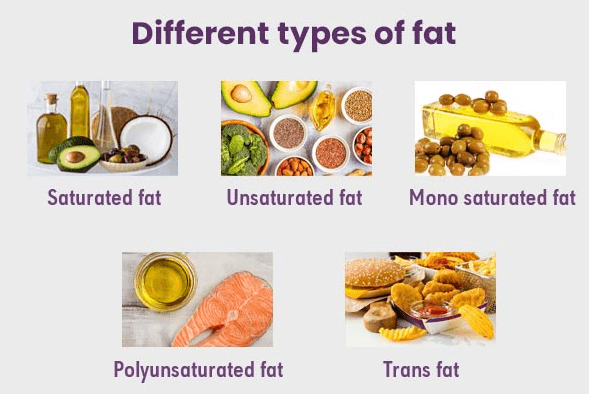Different Types of fats in food

Difference types of fats in foods are provided here. Common 3 types of fats are saturated fats, unsaturated fats, and Trans fats. Now we learn detail about dietary fats with examples. This post includes:
- Fats definition
- types of fats
- Saturated fats
- Unsaturated fats
- Monosaturated fats
- Polyunsaturated fats
- Trans fats
- Much more
keep reading …
What Are Fats?
Fats are one of the nutrients that provide energy to our body and are consumed through diet and/or food.
The fat we eat comes from two sources:
1- Visible fat that is used for cooking or that is added to some foods to season them (salads, vegetables, bread) such as olive oil or that found around the meat or the skin of the chicken, which can be removed and not be consumed.
2- Invisible fat that is “naturally” contained within foods (meats, nuts, dairy products) or that is added during processing (prepared foods, appetizers or snacks, pastries).
3 Different types of fats
Chemically speaking, fats are organic compounds made up of carbon, hydrogen, and oxygen. Its main function is energy, providing 9 kilocalories per gram of fat consumed, twice as many as carbohydrates and proteins (each of these nutrients provide 4 kilocalories per gram).
Fats are made up of triglyceride molecules, in turn, made up of fatty acids. Fatty acids are classified based on the presence of double bonds in their molecule, giving rise to different types of fats:
1: Saturated fats
They are found in foods of animal origin such as meats, sausages, milk, and their derivatives (cheese, ice cream). These are fats that solidify at room temperature.
They can also be found in oils of vegetable origin such as coconut or palm oils (which are consumed through industrial pastries, salty snacks, and processed products).
The consumption of saturated fats favors an increase in blood cholesterol levels, LDL cholesterol (bad cholesterol), being one of the main risk factors for heart disease.
2: Unsaturated fats
(they have double bonds): they are found in foods of vegetable origin such as vegetable oils (olive oil, sunflower, or corn). Also in nuts (walnuts, almonds …) and in seeds (sesame, sunflower, flax). Coconut or palm oils, although they are oils of vegetable origin, contain saturated fatty acids, rather than unsaturated fatty acids.
• Monounsaturated
the most representative is oleic acid present mainly in olive oil and other fats of vegetable origin such as seed oils (sunflower oil, rapeseed oil). They are also found in walnuts, almonds, and avocados.
Replacing saturated fat with unsaturated fat in the diet helps maintain normal blood cholesterol levels. Oleic acid is unsaturated fat.
• Polyunsaturated
They are essential for our body because they cannot synthesize them and they must be supplied through the daily diet to regulate metabolic processes of the cardiovascular, immune, and pulmonary systems, among others.
They are present in foods of plant and animal origin. There are two families within these:
• Omega 3: within this group are linolenic acid, eicosapentaenoic acid (EPA), and docosahexaenoic acid (DHA) very present in oily fish. Omega 3 fatty acids are found in soybean oil, rapeseed oil, dried fruits (walnuts), fatty fish such as salmon, herring, tuna, mackerel, anchovy, sardine, etc.
The consumption of linolenic acid helps to maintain normal blood cholesterol levels. The beneficial effect is obtained with a daily intake of 2 grams of this fatty acid.
Omega 6: within this group is the linoleic acid present in soybean oil, corn oil, sunflower oil, and in dried fruits (walnuts, among others).
The consumption of linoleic acid contributes to maintaining normal blood cholesterol levels. The beneficial effect is obtained with a daily intake of 10 grams of linoleic acid.
3: Trans fats
they are unsaturated fats that are formed in the industrial processing of some foods known as hydrogenation, during which they change their configuration and go from being unsaturated fats to saturated fats, turning into solid fats. They are found in fried foods, snacks, baked goods (biscuits, muffins, cookies), and prepared meals *.
Naturally, they can also be present in foods that come from ruminant animals such as fats and beef, and sheep or in dairy products.
The consumption of trans fatty acids causes in the body a more negative effect than saturated fat since it increases the levels of LDL cholesterol and triglycerides and also reduces HDL cholesterol (good cholesterol) in the blood, increasing the risk of suffering from coronary and heart diseases.